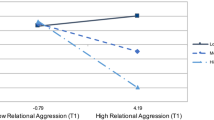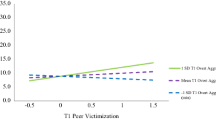Abstract
Although the link between reactively aggressive behavior and depressive symptoms in childhood has been demonstrated in previous work, few studies have examined how peer factors may influence this association. Examining the role of peers in the link between reactive aggression and depressive symptoms is necessary, as peers have been found to buffer the impact of factors that contribute to depressive symptoms in childhood. Accordingly, we examined whether intimate exchange with a best friend moderated the association between reactive aggression and depression in childhood in a sample of 115 children (aged 5–14; M = 8.88; 87 % minority; 53 % male) who attended a community based summer program. Consistent with expectation, reactive aggression was positively associated with child depressive symptoms whereas proactive aggression was negatively associated with depressive symptoms. Further, the interaction between intimate exchange and reactive aggression was associated with child depressive symptoms. Specifically, the association between reactive aggression and depressive symptoms was weaker when levels of intimate exchange were high. Thus, the current study suggests that close peer relationships may help to buffer the link between reactively aggressive behavior and depressive symptoms. Implications for findings include the need to target friendships to help prevent depressive symptoms for reactively aggressive youth.


Similar content being viewed by others
References
Achenbach, T. M. (1991). Manual of the teacher’s report form and 1991 profile. Burlington, VT: University of Vermont, Department of Psychiatry.
Aiken, L. S., & West, S. G. (1991). Multiple regression: Testing and interpreting interactions. Thousand Oaks, CA: Sage Publications, Inc.
Aronen, E. T., & Soininen, M. (2000). Childhood depressive symptoms predict psychiatric problems in young adults. Canadian Journal of Psychiatry, 45, 465–470.
Bandura, A. (1973). Aggression: A social learning analysis. Englewood Cliffs, NJ: Prentice Hall.
Baron, R. A., & Richardson, D. R. (1994). Human aggression (2nd ed.). New York, NY: Plenum Press.
Bayer, J. K., Sanson, A. V., & Hemphill, S. A. (2006). Parent influences on early childhood internalizing difficulties. Journal of Applied Developmental Psychology, 27, 542–559.
Berkowitz, L. (1993). Aggression: Its causes, consequences and control. Philadelphia, PA: Temple University Press.
Capaldi, D. M. (1991). Co-occurrence of conduct problems and depressive symptoms in early adolescent boys: I. Familial factors and general adjustment at grade 6. Development and Psychopathology, 3, 277–300.
Card, N. A., & Little, T. D. (2006). Proactive and reactive aggression in childhood and adolescence: A meta-analysis of differential relations with psychosocial adjustment. International Journal of Behavioral Development, 30, 466–480.
Cardoos, S. L., & Hinshaw, S. P. (2011). Friendship as a protection from peer victimization for girls with and without ADHD. Journal of Abnormal Child Psychology, 39, 1035–1045.
Cicchetti, D., & Rogosch, F. A. (1997). The role of self-organization in the promotion of resilience in maltreated children. Development and Psychopathology, 9, 797–815.
Costello, E. J., Erkanli, A., & Angold, A. (2006). Is there an epidemic of child or adolescent depression? Journal of Child Psychology and Psychiatry, 47, 1236–1271.
Crick, N. R. (1997). Engagement in gender normative versus non normative forms of aggression: Links to social-psychological adjustment. Developmental Psychology, 33(4), 610–617.
Crick, N. R., & Dodge, K. A. (1996). Social information-processing mechanisms in reactive and proactive aggression. Child Development, 67, 993–1002.
Crick, N. R., & Grotpeter, J. K. (1995). Relational aggression, gender, and social-psychological adjustment. Child Development, 66, 710–722.
Day, D. M., Bream, L. A., & Pal, A. (1992). Proactive and reactive aggression: An analysis of subtypes based on teacher perceptions. Journal of Clinical Child and Adolescent Psychology, 21, 210–217.
De Los Reyes, A., & Kazdin, A. E. (2005). Informant discrepancies in the assessment of childhood psychopathology: A critical review, theoretical framework, and recommendations for further study. Psychological Bulletin, 131, 483–509.
Dodge, K. A., & Coie, J. D. (1987). Social-information-processing factors in reactive and proactive aggression in children’s peer group. Journal of Personality and Social Psychology, 53, 1146–1158.
Dodge, K. A., Lochman, J. E., Harnish, J. D., Bates, J. E., & Pettit, G. S. (1997). Reactive and proactive aggression in school children and psychiatrically impaired chronically assaultive youth. Journal of Abnormal Psychology, 106, 37–51.
Fanti, K. A., & Henrich, C. C. (2010). Trajectories of pure and co-occurring internalizing and externalizing problems from age 2 to age 12: Findings from the National Institute of Child Health and Human Development Study of Early Child Care. Developmental Psychopathology, 46, 1159–1175.
Fite, P. J., & Colder, C. R. (2007). Proactive and reactive aggression and peer delinquency: Implications for prevention and intervention. The Journal of Early Adolescence, 27, 223–240.
Fite, P. J., Raine, A., Loeber, R., Stouthamer-Loeber, M., & Pardini, D. A. (2010a). Reactive and proactive aggression in adolescent males: Examining differential outcomes 10 years later in early adulthood. Criminal Justice and Behavior, 37, 141–157.
Fite, P. J., Rathert, J. L., Stoppelbein, L., & Greening, L. (2012). Social problems as a mediator of the link between reactive aggression and withdrawn/depressed symptoms. Journal of Child and Family Studies, 21, 184–189.
Fite, P. J., Stoppelbein, L., & Greening, L. (2009). Proactive and reactive aggression in a child psychiatric inpatient population. Journal of Clinical Child & Adolescent Psychology, 38, 199–205.
Fite, P. J., Vitulano, M., Wynn, P., Wimsatt, A., Gaertner, A., & Rathert, J. (2010b). Influence of perceived neighborhood safety on proactive and reactive aggression. Journal of Community Psychology, 38, 757–768.
Greening, L., Stoppelbein, L., Fite, P. J., Dhossche, D., Erath, S., Brown, J., et al. (2008). Pathways to suicidal behaviors in childhood. Suicide and Life Threatening Behavior, 38, 35–45.
Grotpeter, J. K., & Crick, N. R. (1996). Relational aggression, overt aggression, and friendship. Child Development, 67, 2328–2338.
Guibord, M., Bell, T., Romano, E., & Rouillard, L. (2011). Risk and protective factors for depression and substance use in an adolescent child welfare sample. Children and Youth Services Review, 33, 2127–2137.
Hodges, K., Gordon, Y., & Lennon, M. P. (1990). Parent-child agreement on symptoms assessed via a clinical research interview for children: The child assessment schedule (CAS). Journal of Child Psychology and Psychiatry, 31, 427–436.
Holmbeck, G. N. (2002). Post-hoc probing of significant moderational and mediational effects in studies of pediatric populations. Journal of Pediatric Psychology, 27, 87–96.
Hoza, B., Molina, B. S. G., Bukowski, W. M., & Sippola, L. K. (1995). Peer variables as predictors of later childhood adjustment. Development and Psychopathology, 7, 787–802.
Javdani, S., Sadeh, N., & Verona, E. (2011). Suicidality as a function of impulsivity, callous-unemotional traits, and depressive symptoms in youth. Journal of Abnormal Psychology, 120, 400–413.
Jensen, P. S., Rubio-Stipec, M., Canino, G., Bird, H. R., Dulcan, M. K., Schwab-Stone, M. E., et al. (1999). Parent and child contributions to diagnosis of mental disorder: Are both infomants always necessary? Journal of the American Academy of Child and Adolescent Psychiatry, 38, 1569–1579.
Kistner, J., Counts-Allan, C., Dunkel, S., Hardee Drew, C., David-Ferdon, C., & Lopez, C. (2010). Sex differences in relational and overt aggression in the late elementary school years. Aggressive Behavior, 36, 282–291.
Little, T. D., Henrich, C., Jones, S. M., & Hawley, P. H. (2003). Disentangling the “whys” from the “whats” of aggressive behaviour. International Journal of Behavioral Development, 27, 122–133.
Loeber, R., Green, S. M., & Lahey, B. B. (1990). Mental health professionals’ perception of the utility of children, mothers, and teachers as informants on childhood psychopathology. Journal of Clinical Child Psychology, 19, 136–143.
Marsee, M. A., Barry, C. T., Childs, K. K., Frick, P. J., Kimonis, E. R., Muñoz, L. C., et al. (2011). Assessing the forms and functions of aggression using self-report: Factor structure and invariance of the peer conflict scale in youths. Psychological Assessment, 23, 792–804.
Marsee, M. A., & Frick, P. J. (2007). Exploring the cognitive and emotional correlates to proactive and reactive aggression in a sample of detained girls. Journal of Abnormal Child Psychology, 35, 969–981.
Michael, K. D., & Merrell, K. W. (1998). Reliability of children’s self-reported internalizing symptoms over short to medium length time intervals. Journal of the American Academy of Child and Adolescent Psychiatry, 37, 194–201.
Mikami, A. Y. (2010). The importance of friendship for youth with attention-deficit/hyperactivity disorder. Clinical Child and Family Psychology Review, 13, 181–198.
Miller, J. D., & Lynam, D. R. (2006). Reactive and proactive aggression: Similarities and differences. Personality and Individual Differences, 41, 1469–1480.
Morrow, M. T., Hubbard, J. A., McAuliffe, M. D., Rubin, R. M., & Dearing, K. F. (2006). Childhood aggression, depressive symptoms, and peer rejection: The mediational model revisited. International Journal of Behavioral Development, 30, 240–248.
Morrow, M. T., Hubbard, J. A., Rubin, R. M., & McAuliffe, M. D. (2008). The relation between childhood aggression and depressive symptoms: The unique and joint mediating roles of peer rejection and peer victimization. Merrill-Palmer Quarterly, 54, 316–340.
Myers, R. (1990). Classical and modern regression with applications (2nd ed.). Boston, MA: Duxbury.
Nangle, D. W., Erdley, C. A., Newman, J. E., Mason, C. A., & Carpenter, E. M. (2003). Popularity, friendship quantity, and friendship quality: Interactive influences on children’s loneliness and depression. Journal of Clinical Child & Adolescent Psychology, 32, 546–555.
Panak, W. F., & Garber, J. (1992). Role of aggression, rejection, and attributions in the prediction of depression in children. Development and Psychopathology, 4, 145–165.
Parker, J. G., & Asher, S. R. (1993). Friendship and friendship quality in middle childhood: Links with peer group acceptance and feelings of loneliness and social dissatisfaction. Developmental Psychology, 29, 611–621.
Poulin, F., & Boivin, M. (1999). Proactive and reactive aggression and boys’ friendship quality in mainstream classrooms. Journal of Emotional and Behavioral Disorders, 7, 168–177.
Poulin, F., & Boivin, M. (2000). Reactive and proactive aggression: Evidence of a two-factor model. Psychological Assessment, 12, 115–122.
Price, J. M., & Dodge, K. A. (1989). Reactive and proactive aggression in childhood: Relations to peer status and social context dimensions. Journal of Abnormal Child Psychology, 17, 455–471.
Putallaz, M., Grimes, C. L., Foster, K. J., Kupersmidt, J. B., Coie, J. D., & Dearing, K. (2007). Overt and relational aggression and victimization: Multiple perspectives within the school setting. Journal of School Psychology, 45, 523–547.
Raine, A., Dodge, K. A., Loeber, R., Gatzke-Kopp, L., Lynam, D. R., Reynolds, C., et al. (2006). The reactive proactive aggression questionnaire: Differential correlates of reactive and proactive aggression in adolescent boys. Aggressive Behavior, 32, 159–171.
Rubin, K. H., Bukowski, W. M., & Parker, J. G. (1998). Peer interactions, relationships, and groups. In W. Damon & N. Eisenberg (Eds.), Handbook of child psychology (5th ed., Vol. 3 Social, emotional, and personality development, pp. 619–700). Hoboken, NJ: Wiley.
Salmivalli, C., Ojanen, T., Haanpää, J., & Peets, K. (2005). “I’m OK but you’re not” and other peer-relational schemas: Explaining individual differences in children’s social goals. Developmental Psychology, 41, 363–375.
Schmidt, M. E., & Bagwell, C. L. (2007). The role of friendships in overtly and relationally victimized boys and girls. Merrill-Palmer Quarterly, 53, 439–460.
Tomada, G., & Schneider, B. H. (1997). Relational aggression, gender, and peer acceptance: Invariance across culture, stability over time, and concordance among informants. Developmental Psychology, 33, 601–609.
Vitaro, F., Brendgen, M., & Trembly, R. E. (2002). Reactively and instrumentally aggressive children: Antecedent and subsequent characteristics. Journal of Child Psychology and Psychiatry, 43, 495–505.
Author information
Authors and Affiliations
Corresponding author
Rights and permissions
About this article
Cite this article
Preddy, T.M., Fite, P.J., Wimsatt, A.R. et al. The Role of Intimate Exchange in the Link Between Reactive Aggression and Child Depressive Symptoms. J Child Fam Stud 23, 510–520 (2014). https://doi.org/10.1007/s10826-012-9710-1
Published:
Issue Date:
DOI: https://doi.org/10.1007/s10826-012-9710-1




